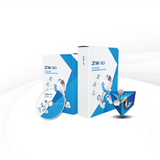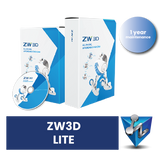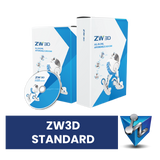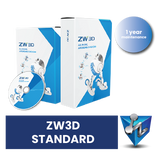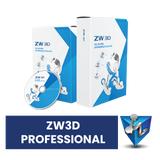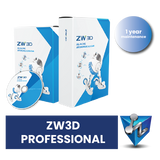ZW3D, an integrated CAD/CAM solution designed for the whole process of product development, features the fastest kernel for Solid-Surface Hybrid Modeling, non-solid mold parting and smart CNC machining strategy from 2-axis to 5-axis. It brings customers multiple benefits such as reduced costs, optimized design workflow and improved efficiency.
Features
ZW3D LITE
|
ZW3D Standard
Advance CAD Function
Application
|
ZW3D Professional
Advanced CAD function
Application
|
For more features, please click: ZW3D Key Features Video
System Requirements

FAQ
How ZW3D CAD Module Drive Innovative Product Design?
-
Multi-Object File management
Amid a lot of qualities of this program, the file management system of ZW3D CAD is highly laudable. Users can store all kinds of information like assembly, CAM plan, and 2D sheet only in one file to keep all the files managed. Apart from this, the option of a conventional one file-object has been included to provide you with all facilities. With this powerful function, more time can be spent on innovative product design instead of file management.
2. Unique Solid-Surface Hybrid Modeling Technology
In ZW3D, the designer does not even need to be concerned whether the object is solid or a surface. The reason that the Boolean operation for the surface can get performed directly with solid geometries. In the meantime, unique solid-surface hybrid modeling technology makes it more flexible to create a perfect model, so that you have more time to look for creativity and inspiration.
3. Better Design Cooperation
The ZW3D CAD module originates diversified standard 2D sheets with views, dimensions, and BOM (bill of materials) table from assemblies and parts to offer better cooperation and brainstorming of product design in the team. Along with this, it can read 3D CAD and 2D sheet files in some format like Catia, Pro-engineering, Solid Works, Solid-Edge, and any other software.
4. Flexible Embossing, Morphing & Wrapping
The ZW3D CAD module facilitates flexible embossing, wrapping, and morphing. Using a raster image, it quickly embosses a high-precision surface. In the same way, it provides solid, and surface data to make the wrapping and morphing flexible. With the help of these facilities, designers can be more creative and flexible in product design.
5. Product Verification Tools
To assess the product structure and surface quality, visual analysis tools are used, including draft angle, Gaussian curvature, contour stripe, and thickness analysis. On the other hand, there is a dynamic section view and interface check to help you know whether the parts and assembly fit with each other or not. Moreover, you can view the animation to make sure about the design assembly, as it can better demonstrate its working mechanism. These tools let your innovative product design shine even in the last stage.
What are the requirements of mold design?
-
Molding material selection
Besides the cost consideration, manufacturers need to determine which mold material would deliver the injected plastic product of choice. Some thermoplastics may not be compatible with material that make up mold cavities due to fundamental differences in physical and chemical properties. By selecting the mold material before injection molding takes place ensures that only compatible materials go together, which saves valuable time and resources.
2. Tolerance
A worthy recommendation during mold design is to factor a degree of tolerance into molded parts due to the common experience of shrinking resins. You can always use a tight or loose tolerance depending on the properties of the thermoplastic resin you intend to use.
3. Wall thickness
Thickness analysis for a mold verifies the manufacturability of product structure. The thickness of the mold is yet another factor that affects cost directly, so it is often a good idea to specify it when formulating the mold design. The thickness also influences the properties — thermal, mechanical, impact, etc. of the end product. Depending on the plastic products' end-use, the thickness adopted can vary, but it is often good practice to ensure that the thickness is uniform all around the mold.
4. Bosses and Gusset requirements
The Boss in a molded part helps provides points of appendage, while Gussets give support to items attached through a boss. Establishing the requirements of these parts during mold design; for example, the tolerance is very critical to ensuring the functionality and practicability of the final molded product.
5. Draft angle
It is now standard practice to define the draft angles in the molded parts, because as we mentioned earlier, it makes it easier to disengage the mold from the formed products. Straight-angled parts of the mold could affect the seamless release of mold thereby, interrupting the mass production process.
What benefits you stand to gain from using ZW3D CAD for mold design?
ZW3D is an all-in-one software package made to address the diverse needs of mold design. Everything from the intuitive UI to its easy-to-use library of molding tools focuses on producing realistic yet accurate designs.
- Specialized Tools for product verification Besides the vast libraries, ZW3D CAD also offers designers specialized tools that are proprietary to the software alone, which helps to create responsive and accurate designs. A notable one is the verification tool that includes; the Gaussian curvature, Draft checking, undercut analysis, and many more. These tools help verify the structure and quality of products, carry out mold analysis, and help effect correction present in the mold design, thereby improving its quality for manufacture.
-
Fast Core-cavity Parting to Accelerate Mold Design Using parting lines in mold design helps define the direction of mold opening for easy ejection during the injection process. ZW3D CAD gives designers the capacity to split any part (simple or complex) of the mold's core and cavity from an imperfect solid block at any instance, which helps to boost workflow and shorten the design time.
- Abundant Customizable Library of Mold Bases & Components with Different standards ZW3D has an archive loaded with numerous mold bases for designers to choose from, all of which are fully customizable to meet your unique needs. These libraries are also of the standard required of mold bases across the globe, so designers can say goodbye to creating mold designs from scratch, saving time on the entire design process.
- Efficient Solutions for Complex Electrode Design Electrode design is now next level with ZW3D, with tools and external plugins like Electrode Focus™ that ZW3D CAD supports. Designers can now create robust electrode geometry, edit and merge electrode drawings. The validation prowess of ZW3D also extends here as manufacturers can now validate electrode designs. Hence, enabling the creation of precision-based electrode designs.
-
Excellent Time Saver for Reducing Cost ZW3D acknowledges the need for speed in the design process, which is why the software is made to be very quick in execution. Everything from the fast software engine, to the intuitive interface and the non-solid mold parting without healing of ZW3D CAD, is to ensure ample time savings on cost evaluation when carrying out designs.
Is there any backup mechanism in ZW3D? How does it work?
Yes, there are several backup mechanisms in ZW3D. But the most suggested way is to keep the option “Auto backup per file per day after save” on (it is on by default). This option means that for every file, it will be backup automatically at the first save every day. If any unexpected issue happens, at least you can roll back to the results of yesterday’s work. The file is always located in the same directory with the original file and is hidden. If you want to use it, you need to show the hidden file, and remove the file extension “.z3bak”. After that, open it in ZW3D.
Does ZW3D support updating parts according to the dimension changes in 2D drawings?
Yes. You just need to choose the “Show dimensions from part” option in the View Attributes dialog box, then right click the dimension and choose the “Modify Part Dimension” option. Then the 3D model will be updated once the dimension is modified in the 2D drawing.
How to share ZW3D configuration settings among different PCs?
Since ZW3D 2020, we’ve provided a useful tool called “User Folder Manager”, which can be used to clear the whole user folder or just the custom configurations, and also the cache files by “Clear auto output files”. As for the configuration sharing, you can save the configurations you want to share by “Save current configurations”, and then load it on other computers to reuse by “Load backup configurations”.
Can ZW3D read the material info from CATIA® files?
Yes, ZW3D can read the material info from CATIA® files directly in the 2021 version. What’s more, ZW3D can read all the mainstream 3D CAD file formats, like Z3, CATPart, prt, asm, sldprt, par, ipt, sat, dwg, dxf, iges, step, x_t, 3dxml, x cgm, obj, etc., as well as their attributes, including hidden components, suppressed components, hidden entities, user custom attributes, material density, etc. Please note that the user custom attributes can only be captured from parts, components and assemblies, instead of the shapes in them.







